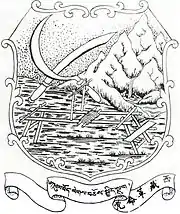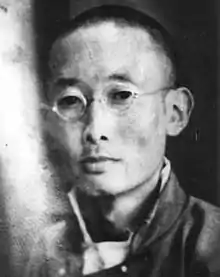Tibet Improvement Party
The Tibet Improvement Party (Tibetan: ནུབ་བོད་ལེགས་བཅོས་སྐྱིད་སྡུག, Wylie: nub-bod-legs-bcos-skyid-sdug;[1] Chinese: 西藏革命黨; pinyin: Xīzàng Gémìngdǎng) was a nationalist, revolutionary, anti-feudal and pro-Republic of China political party in Tibet. It was affiliated with the Kuomintang and was supported by mostly Khampas, with the Pandatsang family playing a key role.
Tibet Improvement Party | |
|---|---|
 | |
| Tibetan name | ནུབ་བོད་ལེགས་བཅོས་སྐྱིད་སྡུག |
| Chinese name | 西藏革命黨 |
| Leader | Pandatsang Rapga |
| Founder | Pandatsang Rapga |
| Founded | 1939 |
| Dissolved | defunct circa 1950 |
| Headquarters | Kalimpong |
| Ideology | Three Principles of the People Secularism |
| International affiliation | Kuomintang |
Names
The Tibetan, Chinese, and English versions of the party names all have separate meanings. The Chinese name (Chinese: 西藏革命黨; pinyin: Xīzàng Gémìngdǎng) means "Tibet Revolutionary Party".[2] In English, it is known as the Tibet Improvement Party or alternatively the Tibetan Progressive Party.[3][4] The Tibetan name (Tibetan: ནུབ་བོད་ལེགས་བཅོས་སྐྱིད་སྡུག, Wylie: nub-bod-legs-bcos-skyid-sdug) translates as "Western Tibet Reform Party".
Background
The party was founded in 1939 in Kalimpong in India by Pandatsang Rapga,[5] who came from the extensive Pandatsang family, a wealthy wool merchant family from Kham.[6] The other core members of the movement were Thubten Kunphela, the Buddhist reformist monk Gendün Chöpel[7] and the poet Canlocen. Kunphela was the most powerful man in Tibet after the 13th Dalai Lama, Thubten Gyatso, in the period between 1931 and 1933. After the death of the Dalai Lama, Kunphela lost his dominant position and was exiled. In 1937 he managed to flee and settled in Kalimpong.
Beliefs
The party considered the then government of Tibet as entirely outdated and feudal, and sought a modern, secular government which would improve infrastructure, introduce newer technology, better education, and a standing army.
Pandatsang Rapga was strongly influenced by the ideas of Sun Yat-sen, especially his Three Principles of the People doctrine. He believed that change in Tibet would only be possible in a manner similar to when the Qing Dynasty was overthrown in China, and borrowed the theories and ideas of the Kuomintang as the basis for his model for Tibet. The party was funded by the Kuomintang and by the Pandatsang family. It was said that Rapga "was a devout believer in the political ideology of Sun Yat-sen and had translated some of Sun's more important writings into Tibetan", including the Three Principles of the People. The Kuomintang General Huang Musong, who was also Chairman of the Mongolian and Tibetan Affairs Commission, talked Rapga into traveling to China in 1936 to join the commission. The Tibet Improvement Party had "a hundred or so sympathizers among Khamba traders" according to Melvyn C. Goldstein.[8] Rapga hailed the three principles of Dr. Sun for helping Asian peoples against foreign imperialism and called for the feudal system to be overthrown. In addition, he stated that "The Sanmin Zhuyi was intended for all peoples under the domination of foreigners, for all those who had been deprived of the rights of man. But it was conceived especially for the Asians. It is for this reason that I translated it. At that time, a lot of new ideas were spreading in Tibet", during an interview in 1975 by Dr. Heather Stoddard.[9]
The ultimate goal of the party regarding the future of Tibet was that Tibet would become an autonomous republic within the Republic of China. Rapga stated that the party goal was revolution and "liberation of Tibet from the existing tyrannical government".[6]
It is difficult to appraise the actual political power of the party. The Tibetan government of the Dalai Lama controlled the western part of Kham, which was one third of the entire Kham region, however, there was significantly large support for some ideas of the movement. The relationship between many Khampas and the Tibetan government in Lhasa was very negative. Hundreds of traders from Kham and a section of the Pandatsang family saw the party as an instrument to create an independent Kham state equally independent of both China and the Dalai Lama's Tibetan state. The 9th Panchen Lama Thubten Choekyi Nyima, who was also pro-Chinese and worked with the Republic of China, also adopted the ideas of Sun Yat-sen like Rapga.[10]
Activities
The Republic of China Kuomintang government under Chiang Kai-shek sought to extend Chinese influence in Tibet. Chiang covertly propped up and financed Rapga and his movement. Rapga wanted to battle the Tibetan Army with a pro-China Khampa militia, seeking Chiang's assistance in September 1943 right before the Cairo Conference. Rapga used the term "hopelessly ill-suited for the modern world" to describe the Tibetan government of the Dalai Lama. The Tibet Improvement Party openly supported the Kuomintang and the Republic of China against the Lhasa government of Tibet. Chiang gave a Chinese passport to Rapga, as well as 100,000 yuan every month.[11][12]
In 1945, Rapga sent Gendün Chöphel on a mission to Lhasa via Tawang and Bhutan to draw maps of the area, while masquerading as a pilgrim beggar monk.[13] When Rapga placed a request for 2,000 membership cards and 4,000 membership forms, the British official H. E. Richardson caught wind of his activities in Kalimpong and the existence of the Tibet Improvement Party. The British deliberated among themselves whether the Tibetan government should be tipped off about the party.[14] The Tibet Improvement Party was reported to the Tibetan government on 10 April by Richardson.[15] The extradition of Rapga was then demanded by the Tibetan government on 26 April, but since Rapga declared himself a national of China, Richardson could not go through with the extradition, advising deportation to China instead. Rapga's house was raided on 19 June 1946 for plotting revolution, counterfeiting, and spying, by the police under British orders. Rapga destroyed all relevant party documents beforehand since he was tipped off by the Chinese commissioner in Delhi, but the police searched a suit pocket and found letters documenting Rapga's correspondence with the Chinese over the Tibet Improvement Party.[16] Rapga was ordered to be deported from British India. He requested assistance from the Mongolian and Tibetan Affairs Commission in China to halt the deportation.[17]
The end of the movement
The activities of the party in Kalimpong were eventually noticed by the British. This led to the Tibetan Government becoming aware of the existence of the movement, and in particular of Pandatsang Rapga. The Tibetans demanded the extradition of Rapga to Tibet. This was not possible however, since Pandatsang was in possession of a Chinese passport. He was expelled from British India in 1947 to Shanghai. Kunphela was also expelled and went to Nanjing.
In 1946, Gendün Chöpel disguised as a monk and went to Tibet on behalf of Rapga, to gather intelligence and support for the party. However, he was quickly arrested by the Tibetans and imprisoned until 1950. This event led to the end of the movement.
References
Citations
- 西藏革命党考实
- Original from the University of Michigan London School of Economics and Political Science (1986). Government and opposition, Volume 21. Weidenfeld and Nicolson. Retrieved 27 December 2011.
Tibetan (ie Xizang) Improvement Party. In Chinese: Xizang Gemingdang: Tibet Revolutionary Party. In English: Tibetan Progressist Party. « India Office Records, L/P&S/l 2/4210 Coll. 36/39, 23 October 1943. 36 Oral information.
- Royal Asiatic Society of Great Britain and Ireland (1989). Journal of the Royal Asiatic Society of Great Britain & Ireland. Royal Asiatic Society of Great Britain & Ireland. p. 306. Retrieved 27 December 2011.
Calcutta). The Chinese name for this movement was Xizang gemingdang, roughly "Revolutionary party of the Western Provinces" (Xizang being a general Chinese designation for Tibet, beside Xifan); and the English name usually given it was apparently the Tibetan Progressive Party. Heather Stoddard devotes many interesting pages to her research on this "progressive", or "revolutionary",
- Original from Northwestern University Government and opposition, Volume 21. London School of Economics and Political Science. 1986. Retrieved 27 December 2011.
In Chinese: Xizang Gemingdang: Tibet Revolutionary Party. In English: Tibetan Progressist Party.
- Arpi, Claude. "The Karma of Tibet" (PDF). pp. 51, 53, 56, 66, 80, 94, 95, 96, 97. Archived from the original (PDF) on 23 September 2015. Retrieved 24 April 2014.
- Melvyn C. Goldstein (1991). A history of modern Tibet, 1913-1951: the demise of the Lamaist state. Vol. 1 of A History of Modern Tibet (reprint, illustrated ed.). University of California Press. p. 450. ISBN 0-520-07590-0. Retrieved 27 December 2011.
- Luo, Jia (2009). REFORM IN TIBET AS A SOCIAL MOVEMENT (PDF) (A thesis submitted in conformity with the requirements for the degree of Master of Education Graduate Department of Sociology & Equity Studies in Education Ontario Institute for Studies in Education University of Toronto). pp. 32. 37. Retrieved 24 April 2014.
- Gray Tuttle (2007). Tibetan Buddhists in the Making of Modern China (illustrated ed.). Columbia University Press. p. 152. ISBN 978-0-231-13447-7. Retrieved 27 December 2011.
- Gray Tuttle (2007). Tibetan Buddhists in the Making of Modern China (illustrated ed.). Columbia University Press. p. 152. ISBN 978-0-231-13447-7. Retrieved 27 December 2011.
- Gray Tuttle (2007). Tibetan Buddhists in the Making of Modern China (illustrated ed.). Columbia University Press. p. 153. ISBN 978-0-231-13447-7.
- Hsiao-ting Lin (2010). Modern China's ethnic frontiers: a journey to the west. Vol. 67 of Routledge studies in the modern history of Asia (illustrated ed.). Taylor & Francis. p. 95. ISBN 978-0-415-58264-3. Retrieved 27 December 2011.
- Lin, Hsaio-Ting (2011). Tibet and Nationalist China's Frontier: Intrigues and Ethnopolitics, 1928-49. Contemporary Chinese Studies Series. UBC Press. p. 145. ISBN 978-0774859882. Retrieved 24 April 2014.
- Goldstein, Melvyn C. (1991). A History of Modern Tibet, 1913-1951: The Demise of the Lamaist State. University of California Press. p. 453. ISBN 0520911768. Retrieved 24 April 2014.
- Goldstein, Melvyn C. (1991). A History of Modern Tibet, 1913-1951: The Demise of the Lamaist State. University of California Press. p. 454. ISBN 0520911768. Retrieved 24 April 2014.
- Goldstein, Melvyn C. (1991). A History of Modern Tibet, 1913-1951: The Demise of the Lamaist State. University of California Press. p. 456. ISBN 0520911768. Retrieved 24 April 2014.
- Goldstein, Melvyn C. (1991). A History of Modern Tibet, 1913-1951: The Demise of the Lamaist State. University of California Press. p. 458. ISBN 0520911768. Retrieved 24 April 2014.
- Goldstein, Melvyn C. (1991). A History of Modern Tibet, 1913-1951: The Demise of the Lamaist State. University of California Press. p. 460. ISBN 0520911768. Retrieved 24 April 2014.
Cited sources
- Goldstein, Melvyn C. (1991). The demise of the Lamaist State. University of California Press. ISBN 978-0-520-07590-0.
- Kapstein, Matthew (2007). The Tibetans. Oxford: Blackwell Publishing. ISBN 978-0-631-22574-4.
- Lopez Jr., Donald S. (2006). The Madman's Middle Way. The University of Chicago Press. ISBN 978-0-226-49316-9.
